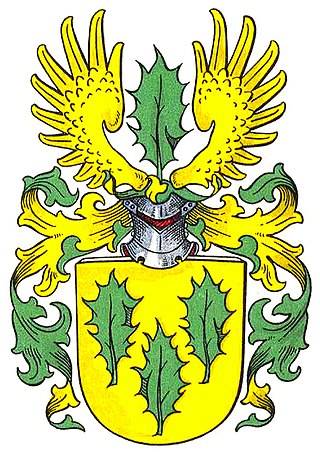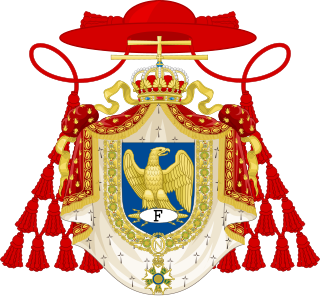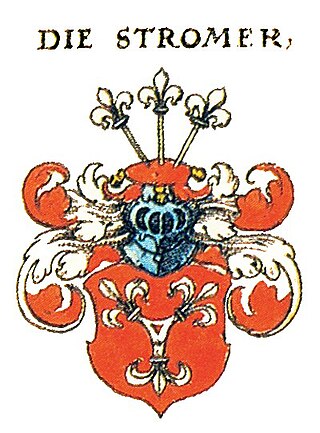
The Meyer zum Pfeil was a prosperous Swiss noble and patrician family from Basel.

The Meyer zum Pfeil was a prosperous Swiss noble and patrician family from Basel.
It appears in Basel in the 15th century and is one of Basel's oldest patrician families, and dominated the city for several centuries together with a handful of other patrician families. The family were prominent merchants, especially cloth merchants, and many family members have served as council members and Mayors of Basel. The family name is derived from the arrow in its coat of arms. Family members used the noble honorific Junker already at the time the family appeared in Basel. [1] [2]
Family members include the renaissance humanist Nikolaus Meyer zum Pfeil, the politician Adelberg Meyer zum Pfeil and the Basel mayor Bernhard Meyer zum Pfeil.

Patricianship, the quality of belonging to a patriciate, began in the ancient world, where cities such as Ancient Rome had a social class of patrician families, whose members were initially the only people allowed to exercise many political functions. In the rise of European towns in the 12th and 13th centuries, the patriciate, a limited group of families with a special constitutional position, in Henri Pirenne's view, was the motive force. In 19th century Central Europe, the term had become synonymous with the upper Bourgeoisie and cannot be interchanged with the medieval patriciate in Central Europe. In the maritime republics of the Italian Peninsula as well as in German-speaking parts of Europe, the patricians were as a matter of fact the ruling body of the medieval town. Particularly in Italy, they were part of the nobility.

Ahlen is a town in North Rhine-Westphalia, Germany, 30 km southeast of Münster. Ahlen is part of the District of Warendorf and is economically the most important town in that district. Ahlen is part of the larger Münster region, and of the historic Münsterland area. The nearby villages of Dolberg, Vorhelm and Tönnishäuschen are part of Ahlen, as well. The largest neighboring town is the city of Hamm to the southwest.

The Burckhardt family alternatively also (de) Bourcard is a family of the Basel patriciate, descended from Christoph (Stoffel) Burckhardt (1490–1578), a merchant in cloth and silk originally from Münstertal, Black Forest, who received Basel citizenship in 1523, and became a member of the Grand Council of Basel-Stadt in 1553.
Danish heraldry has its roots in medieval times when coats of arms first appeared in Europe. Danish heraldry is a branch of the German-Nordic heraldic tradition.

The Uexküll family is the name of an old and distinguished Baltic-German noble family, which derived its name from the town of Uexküll, today in Latvia.

Gentry are "well-born, genteel and well-bred people" of high social class, especially in the past. Gentry, in its widest connotation, refers to people of good social position connected to landed estates, upper levels of the clergy or "gentle" families of long descent who, in some cases, never obtained the official right to bear a coat of arms. The gentry largely consisted of landowners who could live entirely from rental income, or at least had a country estate; some were gentleman farmers. In the United Kingdom, the term gentry refers to the landed gentry: the majority of the land-owning social class who typically had a coat of arms, but did not have a peerage. The adjective "patrician" describes in comparison other analogous traditional social elite strata based in cities, such as free cities of Italy, and the free imperial cities of Germany, Switzerland, and the Hanseatic League.

The Zunfthaus zur Haue or Haus zur Haue is situated at the Limmatquai promenade between Münsterbrücke and Rathausbrücke. It is the guild house of the Zunft zum Kämbel, meaning the guild of the merchants and traders. Neighbored by the Saffran, Zimmerleuten, and Rüden guild houses, it is one of the historically notable buildings in Zürich, Switzerland. The building also houses the relatively expensive restaurant of the same name.
Switzerland, officially the Swiss Confederation, is a collection of semi-autonomous cantons. As membership of the confederation has fluctuated throughout history, each of these cantons has its own unique history and nobility. Typically, each canton had its own constitution, currency, jurisdiction, habits, customs, history, and nobility.

Jakob Meyer zum Hasen was the bürgermeister of the city of Basel from 1516 to 1521. A money changer by profession, he was the first bürgermeister of Basel to be a tradesman, belonging to a guild rather than a member of the aristocracy or a wealthy family. He is known as a patron of the painter Hans Holbein the Younger, having commissioned the Darmstadt Madonna and a double portrait from him.

The Berenberg family was a Flemish-origined Hanseatic family of merchants, bankers and senators in Hamburg, with branches in London, Livorno and other European cities. The family was descended from the brothers Hans and Paul Berenberg from Antwerp, who came as Protestant refugees to the city-republic of Hamburg following the Fall of Antwerp in 1585 and who established what is now Berenberg Bank in Hamburg in 1590. The Berenbergs were originally cloth merchants and became involved in merchant banking in the 17th century. Having existed continuously since 1590, Berenberg Bank is the world's oldest surviving merchant bank.

The Amsinck family is a Dutch-origined patrician family whose members were prominent merchants in multiple countries including the Netherlands, Hamburg, Portugal, England, France, Hanover, Holstein, Denmark, Suriname and India. From the 17th century the Hamburg branch of the family formed part of the city-state's ruling class, the Hanseaten or hereditary grand burghers, who enjoyed legal privileges in Hamburg until 1918. Amsinck has been one of Hamburg's great business families over many centuries, and its members reached the highest positions in Hamburg society, including as senators and head of state. A branch of the family were large plantation owners in Suriname. The Hamburg branch retained a Dutch identity for centuries, often intermarrying with other Dutch-origined patrician families.

Heraldic adoption was in the Kingdom of Poland a legal form of ennoblement and adoption into an existing heraldic clan along with assuming the coat of arms of that clan. It took place as a result of an act issued by the King. The adoption of heraldic arms was a procedure used solely in Polish heraldry and was one of the earlier "old way" forms of ennoblement in Poland. It became particularly popular in the 15th century, especially with prosperous or prestigious city burghers and patricians aspiring to attain noble status, but was abolished by the first half of the 17th century.

The Faesch family, also spelled Fesch, is a prominent Swiss, French, Belgian, Corsican and Italian noble family, originally a patrician family of Basel. Known since the early 15th century, the family received a confirmation of nobility from the Holy Roman Emperor in 1563. It was continuously represented in the governing bodies of the city-republic of Basel for centuries, and three members served as Burgomasters, i.e. heads of state, namely Remigius Faesch (1541–1610), Johann Rudolf Faesch (1572–1659) and Johann Rudolf Faesch (1680–1762). The family was at times the richest family of Basel, and its rise was partially the result of clever marriage policies.

Sozzini, Sozini, Socini or Socin is an Italian noble family originally from Siena in Tuscany, where the family were noted as bankers and merchants, jurists and humanist scholars. The family has been described as "the most famous legal dynasty of the Italian Renaissance."

Junker Nikolaus Meyer zum Pfeil was a German renaissance humanist and author from Basel. He served as Mayor of Mulhouse and as a member of the Grand Council of Basel.

Abel Socin was a Swiss merchant, politician, law lord (Gerichtsherr) and diplomat from Basel. He was a member of the Grand Council of Basel and served as the envoy of the Swiss Confederation to the French court from 1679.

Henriette Wegner, née Henriette Seyler, was a Norwegian businesswoman and philanthropist, a member of the Hanseatic Berenberg banking dynasty of Hamburg and the wife of the Norwegian industrialist Benjamin Wegner. She was briefly a co-owner of Berenberg Bank, and was also noted for her work for the homeless in Norway. During her life she was a citizen of the city-republic of Hamburg, of France during the Napoleonic Wars, and finally of Norway from 1824.

Von der Mühll or Von der Mühl is a Swiss patrician and noble family.

The Patriciate of the Imperial City of Nuremberg, the families entitled to the Inner Council, represented the actual center of power in Nuremberg until the French occupation in 1806.

The Stromer von Reichenbach are one of the oldest patrician families of the Imperial City of Nuremberg, first mentioned in a document in 1254. The Stromers were represented in the Inner Council from the beginning of the tradition in 1318, with longer interruptions in the 16th and 17th centuries, until the end of the Imperial City period in 1806, and according to the Dance Statute they belonged to the twenty old councilable families.